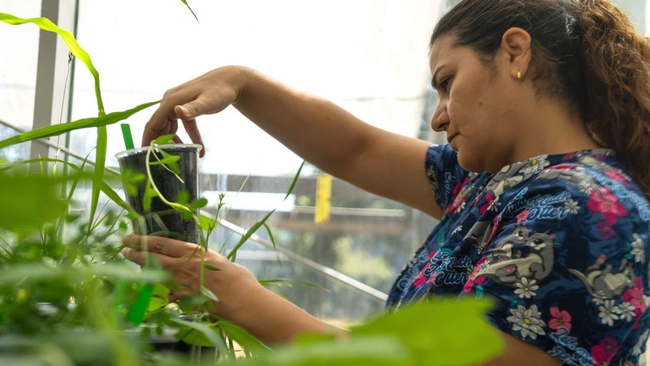Hanson and team battle invasive species
At first glance, Orobanche ramosa looks like an interesting blossoming plant, one that could add a unique flair to flower arrangements. But it's a parasitic weed that attaches to roots, sucks out nutrients and is threatening California's $1.5 billion processing tomato industry.
The weed's tiny seeds — smaller than finely ground pepper — can survive in soil for many decades and be carried by wind, water, soil transfers and even footwear. If found attached to crop plants and reported to the state, farmers are required to destroy the field before harvest, taking large losses not covered by crop insurance.
Its resurgence concerns state regulators and industry, which is helping fund multidisciplinary research at the University of California, Davis, on ways to detect, manage and fight the weed.
“Most of the damage occurs before you can see it,” said Brad Hanson, a professor of Cooperative Extension in the Department of Plant Sciences. “There's a lot of ripples to the problem. We could see it spread to other crops and other regions in the state if it's not managed.”
Across three colleges at UC Davis, researchers are working on ways to detect the pest, manage it in the field throughout its life cycle and develop long-term solutions to minimize the threat to California agriculture. The work is happening in labs and the field, using drones, human spotters and new techniques to sniff out volatile organic chemicals that are emitted when the weed is present.
They are also testing ways to sanitize farm equipment to reduce the risk of spreading seeds from contaminated fields to clean ones. And they are testing dozens of other crops to see if they are susceptible or could be used as false hosts to kill off the Orobanche seeds in the soil.
Invasive species alert: A weed resurgence in California agriculture
The California Department of Food and Agriculture and industry had a program from the 1950s through the 1970s to eradicate the weed, which is commonly known as branched broomrape. But the weed showed up again in Yolo County in 2017.
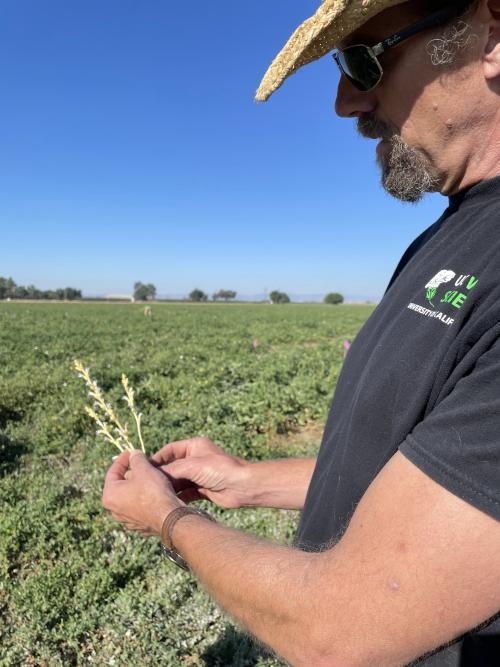
“Believing it to be eradicated, the industry moved on to other challenges,” said Zach Bagley, managing director for the California Tomato Research Institute Inc., or CTRI. “We've been aggressive, with this as our top priority, and we've been putting the funding behind it.”
CTRI's research budget for 2022 and 2023 is nearly $1 million, and half of that money has gone to fund six researchers and their teams at UC Davis and UC Davis Chile, as well as some work at University of Wisconsin.
“Unfortunately, or fortunately, tomatoes are going to have to be the tip on the spear of trying to address this,” Bagley said. “UC Davis has relationships with industry. They have the expertise in the areas we need for this problem.”
Last year, CTRI, Corteva and Hanson's team got state permission for an herbicide treatment that, in trials, has reduced Orobanche emergence fourfold. “That management treatment has been used extensively by growers this year,” Bagley said.
The CTRI funding has helped leverage other money, bolstering the research capability.
“It shows the power of the university,” Hanson said. “It shows the kind of things we can do with the research and extension expertise in a land-grant university. When something like this arises, we can spring into action.”
Severe regulatory triggers impact California tomato farmers
It's hard to know quite how far Orobanche has spread.
Yolo County farmers reported 71 to 403 acres affected between 2017 and 2022, with some years seeing less and others more. No cases have been reported this year, Yolo County Agriculture Commissioner Humberto Izquierdo said.
But Orobanche weeds could be sprouting up elsewhere.
“The issue with this pest is that growers are very reluctant to report it and it's not an easy issue to spot,” Izquierdo said. “The regulatory requirements are very strict. Once it's found, we limit harvesting on that field.”
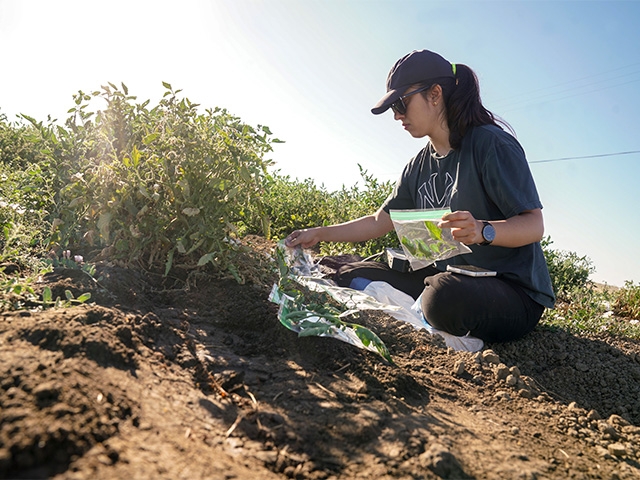
Izquierdo works with canneries and the CTRI to promote good sanitation policies, so the weeds don't spread. But with a limited number of inspectors, it's hard to get a handle on the extent of the problem without consistent reporting.
“If we don't know where the problem is, we can't deal with it,” he said. “It really takes cooperation from industry to be able to move forward.”
Hanson says it's likely that there are more infested fields in Yolo County than what has been reported, and there's no obvious reason Orobanche could not spread to other tomato-producing regions. But the harsh repercussions for reporting can be a barrier: “Do the right thing, lose hundreds of thousands of dollars,” he said.
The low reporting numbers combined with the hardiness, number and sheer longevity of Orobanche seeds requires more than regulatory action.
“This is not something you're going to sweep under the rug,” said Matt Fatino, a Ph.D. student researcher in Hanson's lab. He has been working on chemical control strategies, including on projects with counterparts in Mediterranean climates, where the weed is more prevalent.
Field research on tomato plant diseases promotes sustainable agriculture
A local grower recognized the issue needed research and allows Hanson, Fatino and other UC Davis scientists access to a 3-acre plot in Woodland where tomatoes are planted in infected soil. There, researchers test out different ways to control the weeds on the ground and others take to the air to scan for evidence of the pest.
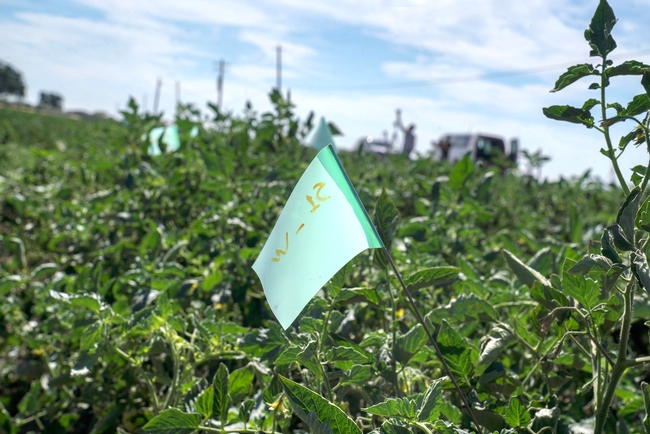
A half dozen other weeds also clustered around that one tomato plant, attached at the roots underground by what looked like an undifferentiated mass once unearthed.
In the distance, students and other lab members kicked at the tomato plants, searching for the weeds and placing tiny flags to mark their presence.
In Fatino's experiment, different herbicides of varying concentrations have been applied via irrigation to the rows in an attempt to gauge what may work best controlling the Orobanche. The chemicals must be authorized with the state and have restrictions on use.
Every week, spotters arrive with differently colored flags to mark their latest finds. In past years, 800-900 flags were planted in the 1-acre experiment.
“It's a needle in a haystack project,” Hanson said.
At that same plot, Ph.D. student Mohammadreza Narimani and others from the Digital Agriculture Laboratory, which is run by associate professor of Cooperative Extension Alireza Pourezza, use drones equipped with special cameras and technology to scan the field.
The lab, which is housed in the College of Engineering and College of Agricultural and Environmental Sciences, specializes in using digital technology and data analytics to support sustainable agriculture.
The team has divided the field into quadrants, flagging spots with and without Orobanche weeds. Four drones fly over the field, equipped with Light Detection and Ranging, or LIDAR, scanners, RGB, multispectral and hyperspectral cameras. As the drones fly, real-time images appear on a laptop, filling in the screen square by square with images and data from the camera's sensors to be analyzed later in the lab.
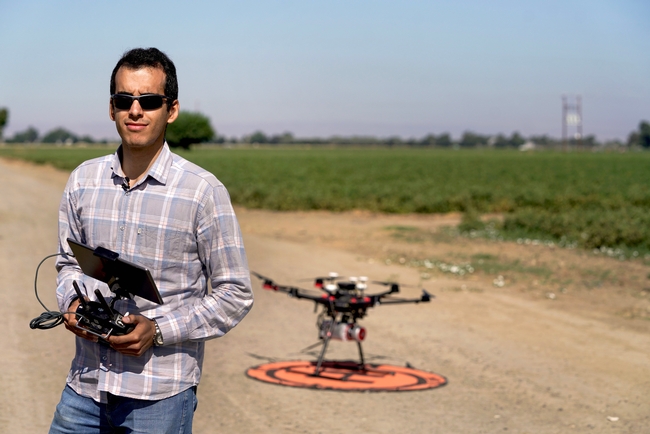
“Different characteristics of plants reflect light in a different way, which results in them appearing in different colors,” Narimani, the drone pilot, said. “We can monitor different levels of nutrients in the plant and identify if there are any signs of broomrape.”
Secure lab research on plant pathology and broomrape weed
Back on campus, the weeds are carefully studied in a secure environment known as the Contained Research Facility, or CRF, which is dedicated to studying invasive plant pests, ranging from pathogens and weeds to nematodes and certain invertebrates like spiders and insects.
The facility is the first of its kind in the west and houses labs, greenhouses and growth chambers. People working in the space must adhere to strict protocols meant to ensure none of the pests escape the space. Waste is sterilized on site and people, plus phones and other personal items brought inside, must shower out to leave the facility.
In a small space set aside for Orobanche, postdoctoral scholar Pershang Hosseini has a handful of projects; Hosseini also is in the Department of Plant Sciences. One of her projects is testing whether certain sanitizing chemicals can kill the seed, removing the threat of Orobanche and other pathogens spreading on farm equipment. Hosseini is working on that project with plant pathologist Cassandra Swett, an associate professor of Cooperative Extension.
Another project involves planting more than two dozen crops to see whether they are susceptible to Orobanche or if they could serve as false hosts, causing the seeds to die out because they germinate but don't find a suitable host to parasitize.
Along those lines, Hosseini is also studying a chemical that is similar to a natural substance in tomato plants that signals Orobanche to germinate when no host exists, essentially causing the seeds to commit suicide.
“No seeds can germinate twice, so this could be a way to directly reduce the amount of seed in the soil seedbank,” Hosseini said.
Innovative plant disease detection: Sniffing out broomrape in tomato plants
Other professors are also using the space for related research, and one project involves smelling volatile organic chemicals.
“We're basically sniffing out diseases or infections or parasites,” said Cristina Davis, professor of mechanical and aerospace engineering.
Davis and her lab director and staff researcher Mitchell McCartney developed a sensor to detect Orobanche by measuring odors emitted from plants affected by the weed.
“The plants tend to off gas an alert signal around themselves to warn other plants,” McCartney said. “There's all this information that's being passed around us in the air, but the human olfactory nerve isn't sensitive enough to pick up on those changes.”
At the Contained Research Facility, tomato plants are enclosed in an airtight space and fresh air is pumped in, while a sponge-like sensor collects what is emitted into the air. Back at their home lab in the College of Engineering, Davis and McCartney superheat the sponges to release volatile organic chemicals.
“It captures a snapshot of odor,” he said.
If a unique chemical signature can be isolated, fields could one day be sniffed for Orobanche weeds, serving as an alert system.
Biological innovations in plant breeding could mean solutions for California farms
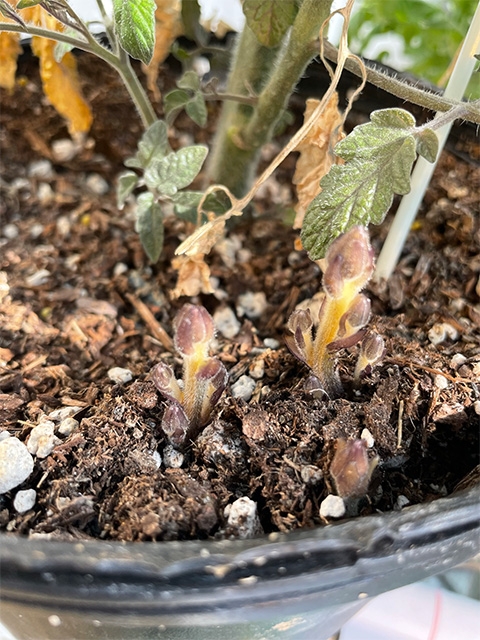
“The goal is to figure out if there are very early gene expressions when plant roots are attached by broomrape,” Sinha said. “Early response is where we feel resistance will lie.”
Brady is looking at if the cell types of tomato plant roots could be modified to create a barrier to the weed from attaching.
“It's a combinational approach to attack from all these different points in the life cycle,” Brady said of the UC Davis research. “It's attacking the attacker.”
For Hanson, the research is among the most collaborative that he's been a part of and shows how real-world problems can be addressed when industry, regulators and researchers work together.
“We're making progress on a major threat to California agriculture,” he said, “and it's really rewarding to be a part of the research team.”
Media Resources
- Brad Hanson, UC Davis Department of Plant Sciences, bhanson@ucdavis.edu
- Emily C. Dooley, College of Agricultural and Environmental Sciences, ecdooley@ucdavis.edu
- Amy Quinton, UC Davis News and Media Relations, 530-601-8077, amquinton@ucdavis.edu
Media kit of images for download.
Original source: UC Davis Dept. of Plant Sciences
Emily Dooley is a Communications Specialist with the College of Agricultural and Environmental Sciences at UC Davis.
